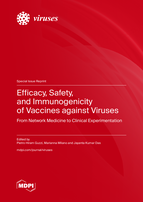Efficacy, Safety, and Immunogenicity of Vaccines against Viruses: From Network Medicine to Clinical Experimentation
A special issue of Viruses (ISSN 1999-4915). This special issue belongs to the section "Viral Immunology, Vaccines, and Antivirals".
Deadline for manuscript submissions: closed (31 August 2023) | Viewed by 14993
Special Issue Editors
Interests: computational biology; data science; bioinformatics; COVID-19
Special Issues, Collections and Topics in MDPI journals
Interests: bioinformatics; network analysis; biological data analysis; COVID-19
Special Issues, Collections and Topics in MDPI journals
Interests: computational bioinformatics; applied data science; machine learning
Special Issues, Collections and Topics in MDPI journals
Special Issue Information
Dear Colleagues,
Despite the availability of effective vaccines against many diseases (e.g., COVID-19, Influenza, Varicella Virus, HPV), there is a need to study both novel and the existing vaccines and create prioritization campaigns to maintain vaccine-induced protection against variant strains and breakthrough infections.
Bioinformatics and network medicine help the research community to investigate the efficacy, safety and immunogenicity of vaccines and the mutual relationships among them.
An increasing body of evidence confirms that the synergistic integration of network medicine and clinical experimentation may improve the quality of existing vaccines as well as the development of novel ones. This Special Issue aims to foster discussion on following topics:
- Development of novel vaccines
- Study of the immunogenicity of existing vaccines
- Age- and sex- based differences
- Introduction of novel prioritisation methods
Dr. Pietro Hiram Guzzi
Dr. Marianna Milano
Dr. Jayanta Kumar Das
Guest Editors
Manuscript Submission Information
Manuscripts should be submitted online at www.mdpi.com by registering and logging in to this website. Once you are registered, click here to go to the submission form. Manuscripts can be submitted until the deadline. All submissions that pass pre-check are peer-reviewed. Accepted papers will be published continuously in the journal (as soon as accepted) and will be listed together on the special issue website. Research articles, review articles as well as short communications are invited. For planned papers, a title and short abstract (about 100 words) can be sent to the Editorial Office for announcement on this website.
Submitted manuscripts should not have been published previously, nor be under consideration for publication elsewhere (except conference proceedings papers). All manuscripts are thoroughly refereed through a single-blind peer-review process. A guide for authors and other relevant information for submission of manuscripts is available on the Instructions for Authors page. Viruses is an international peer-reviewed open access monthly journal published by MDPI.
Please visit the Instructions for Authors page before submitting a manuscript. The Article Processing Charge (APC) for publication in this open access journal is 2600 CHF (Swiss Francs). Submitted papers should be well formatted and use good English. Authors may use MDPI's English editing service prior to publication or during author revisions.
Keywords
- vaccines
- vaccine Security
- computational Bioinformatics
- network Analysis
- data Science









